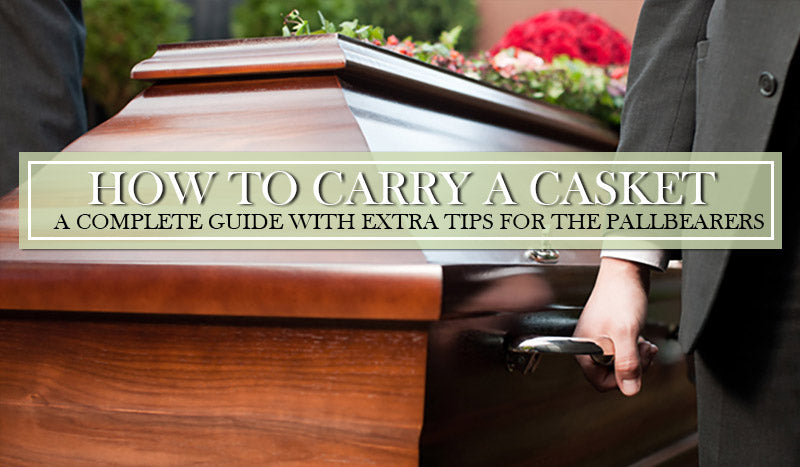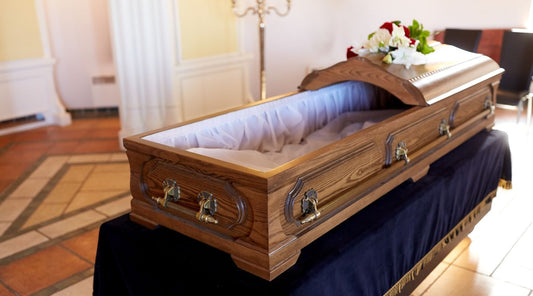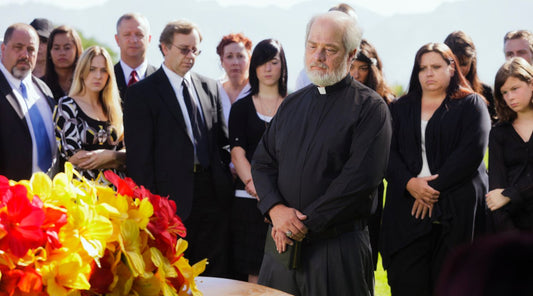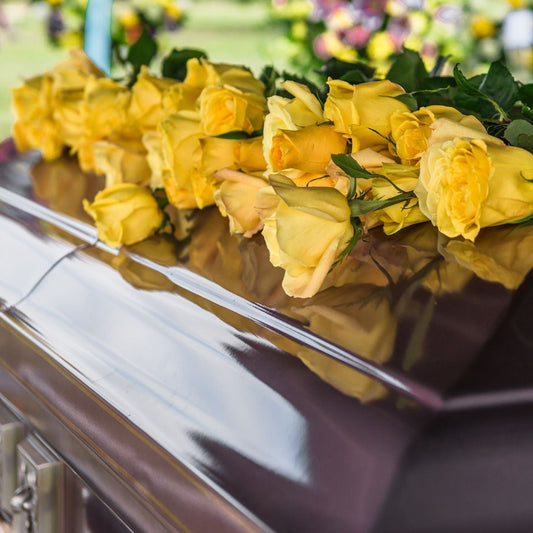
How to Carry A Casket - A complete Guide with Extra Tips for the Pallbearers
Funerals are difficult to plan, mostly if the deceased hasn’t left specific instructions for the ceremony. The grieving family has to take care of many things, choose a casket, the final disposal of the remains, buy the burial plot, and so on. Selecting the pallbearers is one of the many decisions to make in a funeral, and people carrying a casket for the first time should be aware of a number of things that we’re outlining here.
Being a pallbearer is both an honor and a duty - here’s why
You should feel honored if the deceased’s family asks you to carry the casket; it’s a duty that not many people will have in life. It's an unfortunate opportunity, mostly when the deceased was a friend or family. But that only puts pressure on you to do your best; being selected by the family as a pallbearer means that the family trusts you and that you meant a lot to the deceased.

The pallbearer will carry the casket to the final resting place, and it takes 6-8 people to carry a coffin. Pallbearers have to move the casket between different places (from the funeral home to the hearse, and from the hearse to the church). Dignity and respect are the fundamental values to have when you’re a pallbearer. Apart from etiquette, there are also useful and practical tips about carrying the casket with other pallbearers. The casket will have to be moved in the case of traditional burials, perhaps not so much in case of a cremation, where rental or cremation caskets are used.
How should you carry the casket in step with the other pallbearers?
It may sound simple from a distance to carry a casket; you lift and move forward. However, you will be taking the casket with other people, so you will have to synchronize your movements, lift the weight without causing yourself and injury, and so on. Keep reading to find out the best recommendations for carrying a casket.
1. Safety first
Even if the family asks you to help carry the casket, you should first give it a thought. How is your physical health? Have you had any recent neck, shoulder, knee, or back injuries that carrying the casket may aggravate? You shouldn’t accept carrying the coffin if you're risking your health; it could lead to unpleasant accidents in the middle of the ceremony and even cause injury to the other pallbearers.
2. Lift correctly
You may lift the casket and carry it on the shoulders and lower it with the handles if it's load bearing. A shoulder carry looks more impressive, but it will put more strain on the shoulders and upper arms. If the ground is uneven and slippery, carrying the casket on shoulders is safer too.
3. Plan it
It’s also wise to plan out the lifting; see that the pathway is clear, above your head and underfoot. Avoid the slippery areas and the low-hanging doorways, uneven ground, and steps.
Pallbearers must have similar heights, too, with shorter people going in the front and taller people in the back.
4. Mind the weight of the casket
It’s the deceased's body that you have to lift and carry and the casket itself, and the latter can be very heavy. It can weigh 400lbs, in which case six people will be enough for taking the coffin.
5. Walk slowly
It would help if you always walked slowly, as it’s both respectful and practical- the casket is heavy. If you’re taking too large steps, one of the pallbearers may not keep up with you, and it will not show nicely for the people attending the funeral either (where’s the rush?).
Foot always come first and not the head. The casket should always have the foot end towards the driver to be foot first when being driven in the car. It's a symbolic step, as it reminds us of a person walking. It’s also made for practical reasons, as it will reduce the body's risk of purging. It’s essential always to maintain the head raised so that the fluids are kept down.
6. Keep in step and level
It's difficult for people to keep in step, but it's crucial mainly for aesthetical reasons. You won’t get on someone else’s toes too. You only have to copy the pallbearer in front of you, moving as and when he’s moving. If you’re at the front of the casket, you should pay attention to the person leading the casket (the priest, for example). If there’s nobody else at the front, you should walk evenly and as slowly as you can.
While climbing up/down the stairs, you should maintain the casket level as much as you can. When you keep the casket level, you also have to assure that nothing on the top of the casket (flower arrangements) will fall. It’s another way to keep everyone safe and comfortable while carrying the casket. People at the low end will need to lift the casket as much as practical to remain level.
7. Turn clockwise
Again, the clockwise movement has a symbolic meaning, reminding the moving of life. It resembles the clock turning and time passing. Plus, if all pallbearers know that they always have to rotate clockwise, there will be no misunderstanding when having to turn.
8. Use just one hand when holding the handle
You should hold the handle with just one hand when carrying the casket; you may only use both hands when picking up/raising or putting down the casket. Not only that, it's weird, but holding the handle with both hands is uncomfortable and inefficient too.
Use the hand closest to the casket and change regularly with the pallbearer on the opposite side for comfortable carry.
9. Pay attention to instructions
Most of the time, the funeral conductor will tell you what to do. If you don’t know what to do, it’s better not to do anything. Pay attention and wait for the signal without getting nervous about it. It would help if you stayed still and only move when instructed. You don’t want to add an unpleasant moment to the funeral- it’s emotionally draining as it is.
10. Take a deep breath
Carrying the casket is a big responsibility, but you shouldn’t stress too much. You will have other people helping you, and the risk for dropping the casket is relatively low. Even if the handle comes off, the other pallbearers will be there for the rescue. Tripping or falling when carrying the casket will rarely happen.
What if the casket is wheeled?
It would help if you always wheeled the casket by the thumbscrews. If you have to wheel the casket away, you should hold the thumbscrews and not the handle. Even if keeping the thumbscrews seems weird for some, it will provide a more secure grip and control. The handles will be too low for a comfortable grip, forcing the people to bend while walking, which looks less appealing.
Etiquette and attire

Pallbearers typically will gather at the hearse and stay as silent as possible. It would help if you keep your hands in front of your body, hands covering/clasping each other and arms down. Once the ceremony starts, you will have to stay silent until you no longer have to move the casket.
Most of the time, the pallbearer holds the casket with one hand, and the other hands are tucked behind the back. In some services, pallbearers may have designated seats, so you will have to assist the ceremony with the other pallbearers.
As for attire, you should dress conservatively. Tie, proper shoes, and dark suits are best for men, whereas women should wear conservative clothes (skirt or pants, suit set, or a modest dress). Women should avoid high heels and wear flats or low heels.
We should remind you that funeral rituals may vary a lot. Some families decide to have a “celebration of life," in which case a less conservative attire for the pallbearers is recommended.
Blog Author: Tim


